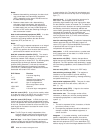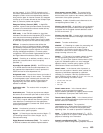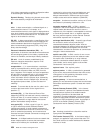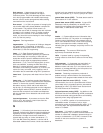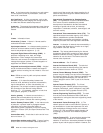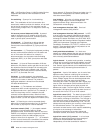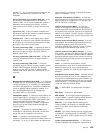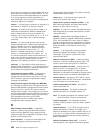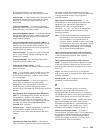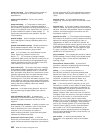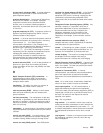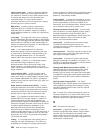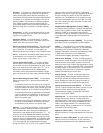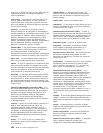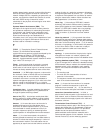the functions of a modem is to enable digital data to be
transmitted over analog transmission facilities. (T) (A)
(2) A device that converts digital data from a computer
to an analog signal that can be transmitted on a
telecommunication line, and converts the analog signal
received to data for the computer.
modulo. (1) Pertaining to a modulus; for example, 9 is
equivalent to 4 modulo 5. (2) See also
modulus
.
modulus. A number, such as a positive integer, in a
relationship that divides the difference between two
related numbers without leaving a remainder; for
example, 9 and 4 have a modulus of 5 (9-4=5;4-9
= -5; and 5 divides both 5 and -5 without leaving a
remainder).
monitor. (1) A device that observes and records
selected activities within a data processing system for
analysis. Possible uses are to indicate significant
departure from the norm, or to determine levels of
utilization of particular functional units. (T) (2)
Software or hardware that observes, supervises,
controls, or verifies operations of a system. (A) (3)
The function required to initiate the transmission of a
token on the ring and to provide soft-error recovery in
case of lost tokens, circulating frames, or other
difficulties. The capability is present in all ring stations.
multicast. (1) Transmission of the same data to a
selected group of destinations. (T) (2) A special form of
broadcast in which copies of a packet are delivered to
only a subset of all possible destinations.
multiple-domain support (MDS). A technique for
transporting management services data between
management services function sets over LU-LU and
CP-CP sessions. See also
multiple-domain support
message unit (MDS-MU)
.
multiple-domain support message unit (MDS-MU).
The message unit that contains management services
data and flows between management services function
sets over the LU-LU and CP-CP sessions used by
multiple-domain support. This message unit, as well as
the actual management services data that it contains, is
in general data stream (GDS) format. See also
control
point management services unit (CP-MSU)
,
management services unit (MSU)
, and
network
management vector transport (NMVT)
.
N
Name Binding Protocol (NBP). In AppleTalk
networks, a protocol that provides name translation
function from the AppleTalk entity (resource) name
(character string) into an AppleTalk IP address (16-bit
number) on the transport layer.
name resolution. In Internet communications, the
process of mapping a machine name to the
corresponding Internet Protocol (IP) address. See also
Domain Name System (DNS)
.
name server. In the Internet suite of protocols,
synonym for
domain name server
.
nearest active upstream neighbor (NAUN). In the
IBM Token-Ring Network, the station sending data
directly to a given station on the ring.
neighbor. A router on a common subnetwork that has
been designated by a network administrator to receive
routing information.
NetBIOS. Network Basic Input/Output System. A
standard interface to networks, IBM personal computers
(PCs), and compatible PCs, that is used on LANs to
provide message, print-server, and file-server functions.
Application programs that use NetBIOS do not need to
handle the details of LAN data link control (DLC)
protocols.
network. (1) A configuration of data processing
devices and software connected for information
interchange. (2) A group of nodes and the links
interconnecting them.
Network Access Server (NAS). A device providing
temporary, on-demand network access to users. This
access is point-to-point using PSTN or ISDN lines.
network accessible unit (NAU). A logical unit (LU),
physical unit (PU), control point (CP), or system
services control point (SSCP). It is the origin or the
destination of information transmitted by the path control
network. Synonymous with
network addressable unit
.
network address. According to ISO 7498-3, a name,
unambiguous within the OSI environment, that identifies
a set of network service access points.
network addressable unit (NAU). Synonym for
network accessible unit
.
network architecture. The logical structure and
operating principles of a computer network. (T)
Note: The operating principles of a network include
those of services, functions, and protocols.
network congestion. An undesirable overload
condition caused by traffic in excess of what a network
can handle.
network identifier. (1) In TCP/IP, that part of the IP
address that defines a network. The length of the
network ID depends on the type of network class (A, B,
or C). (2) A 1- to 8-byte customer-selected name or an
8-byte IBM-registered name that uniquely identifies a
specific subnetwork.
Network Information Center (NIC). In Internet
communications, local, regional, and national groups
460 MRS V3.2 Protocol Config Ref Vol 2



